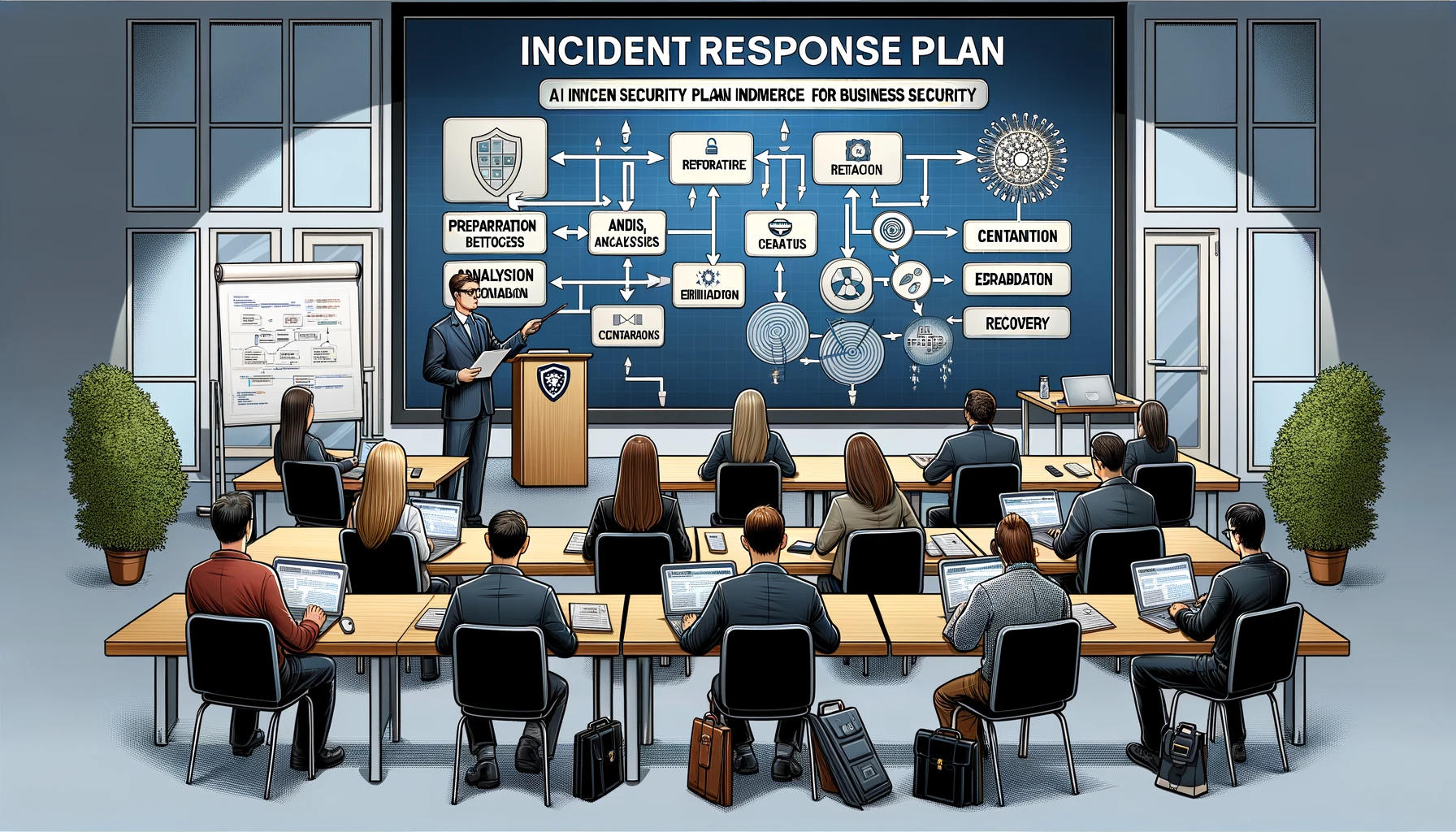Most entrepreneurs find themselves in the chaotic circus of small business management, where cyber threats add a new layer of challenge. But fear not! Let me guide you through the maze of “Incident Response Planning” with a sprinkle of humor and a dash of wisdom. Imagine a beautiful morning when your website suddenly crashes – cyberattack alert!
Do you have a backup plan? If you need help unraveling the complexities of Incident Response, stay tuned for the secret ingredients of a foolproof plan. Assemble Your Avengers – create a team that can distinguish a phishing email from a genuine one. Recognize the Red Flags – be aware of warning signs of cyber intrusions. Contain the Chaos – when disaster strikes, prevent the issue from spreading like wildfire. The Cleanup Operation – once you’ve identified the problem, it’s time to clean up.
Huddle and Learn – gather your team after the crisis for a debrief session to learn and improve. Do not forget, cybersecurity expertise is crucial; it’s like entrusting heart surgery to a specialized surgeon. By sharing my experiences and insights, I hope to fortify your business against digital threats. An incident Response Plan isn’t just for tech giants – it’s imperative for small businesses too. Stay informed, be prepared, and don’t hesitate to seek help when needed. In cybersecurity, being over prepared is better than being caught off guard. So lock those digital doors, and don’t entertain the trolls!
Key Takeaways:
- Incident Response Planning is imperative: Just like you wouldn’t run a circus without a safety net, you shouldn’t run a business without a plan to tackle cyber threats.
- Build a qualified team: Ensure you have a team with the right skills to identify and respond to cyber incidents effectively.
- Recognize the warning signs: Stay alert for unusual activities on your systems that could indicate a cyber intrusion.
- Contain and cleanup: Act swiftly to contain any issues and thoroughly clean up after a cyber incident to prevent further damage.
- Continuous improvement: After dealing with an incident, gather your team to analyze what happened and learn how to strengthen your response for the future.

Recognizing Your Ring of Fire: Types of Cyber Threats
Any entrepreneur navigating cybersecurity needs to be aware of the various types of cyber threats that could potentially harm their business. Understanding these threats is crucial in developing a robust Incident Response Plan to safeguard your company’s digital assets.
| Malware: malicious software designed to infiltrate and damage systems. | Phishing: fraudulent attempts to obtain sensitive information via email or messaging. |
| Ransomware: a type of malware that encrypts data, demanding a ransom for decryption. | DDoS Attacks: overwhelming a system or network to disrupt services. |
| Insider Threats: risks posed by employees, contractors, or partners with access to sensitive data. | Social Engineering: manipulating individuals to divulge confidential information. |
The Sneaky Specimens: Identifying Different Forms of Attacks
Fire up your cybersecurity awareness by familiarizing yourself with the various forms of cyber attacks that could target your business. From the stealthy nature of malware to the deceitful tactics of phishing, each attack has its unique characteristics and potential impact. By understanding these nuances, you can better prepare your defenses and respond effectively in case of an incident.
Spotting the Daring Trapeze Artists: Warning Signs of Intrusion
Now is the time to sharpen your observation skills and be on the lookout for the red flags of a cyber intrusion. Unusual system behavior, unauthorized access attempts, or unexpected changes in network traffic could indicate a potential security breach. It’s necessary to educate your team on these warning signs and establish protocols to promptly address any suspicious activities.
The Art of Taming the Beast: Tips for Preparing Your Incident Response Plan
There’s a wild world out there in cybersecurity, but fear not, fellow entrepreneurs! Crafting an effective Incident Response Plan is your trusty stick to wrangle that beast. Here are some vital tips to guide you through the process with confidence and a touch of humor.
Assembling Your Cybersecurity Avengers: Choosing the Right Team
There’s no superhero solo act when it comes to defending your business against cyber threats. Assemble your cybersecurity Avengers by selecting a team with diverse skills and expertise. Look for individuals who can distinguish a phishing email from a legitimate one, and who understand the intricate dance of cyber intrusions.
- Team Diversity: Ensure your cybersecurity Avengers have a range of skills, from technical know-how to critical thinking.
- Expertise Matters: Consider including members who have experience in IT security, incident response, and risk assessment to cover all bases.
- Continuous Training: Invest in regular training sessions to keep your team sharp and updated on the latest cybersecurity trends and threats.
Recognizing the Red Flags: Tips to Identify a Breach
Avengers, when it comes to cyber threats, being proactive is key. Recognizing the red flags of a potential breach can help you nip the problem in the bud before it escalates. Stay vigilant and keep an eye out for unusual activities or behaviors within your systems. Early detection can save you from a major cybersecurity disaster down the line.
- Unusual System Behavior: Watch out for unexpected system crashes, unusually slow performance, or unauthorized access attempts.
- Spike in Network Traffic: Monitor your network for sudden spikes in traffic, which could indicate a potential cyberattack in progress.
- Phishing Attempts: Educate your team on spotting phishing emails and other social engineering tactics used by cybercriminals to gain access to your systems.
Knowing how to spot the subtle signs of a breach can make all the difference in safeguarding your business from cyber threats. Stay vigilant, stay informed, and remember, a proactive approach is your best defense.
Assume that your cybersecurity Avengers are the first line of defense, and empowering them with the right tools and knowledge is crucial for a robust Incident Response Plan.
Taking the Leap: Step-by-Step Guide to Incident Response Planning
Unlike navigating a crowded circus with hoops of fire, Planning for Incident Response can be a structured process to tackle cyber threats effectively. Let’s break it down step by step to make it as manageable as taming a lion with a feather.
Step One: Contain the Chaos Without Causing a StampedeWithout creating chaos akin to a runaway elephant, containing a cyber incident requires a cool head and a clear plan. As soon as you detect unusual activity or an intrusion, isolate the affected systems to prevent further damage. Identify the source of the issue and disconnect it from the network to stop it from spreading. |
Step Two: The Cleanup Operation – No Clowning AroundOne of the most critical phases, the cleanup operation, is where you roll up your sleeves and get to work. Remove malicious software, restore affected data from backups, and strengthen your defenses to prevent future attacks. It’s like mopping up spilled popcorn after a comedy show – meticulous but necessary for a clean slate. |
Leap: When plunging into the cleanup operation, remember that thoroughness is key. Ensure all entry points are secure, install patches or updates to strengthen vulnerabilities, and engage in training sessions to educate your team about cybersecurity best practices. Don’t overlook any detail, as even a tiny oversight can leave your business vulnerable to repeat attacks.
The Show Must Go On: Factors to Consider Post-Incident
Many entrepreneurs breathe a sigh of relief once the immediate chaos of a cyber incident is contained. However, the journey doesn’t end there. Learning from the act is crucial to fortifying your defenses for the future. It’s like honing your skills after a shaky performance. Here’s where the real magic happens.
Learning from the Act: Huddle and Learn
Now is the time to gather your team around the virtual campfire and dissect what went down. Knowing your weaknesses allows you to strengthen them. Reflect on the incident, analyze the response, and brainstorm ways to enhance your Incident Response Plan. Encourage open communication and a blame-free environment to foster growth and preparedness.
Enhanced Performance: Improving Your Cybersecurity Measures
To enhance your cybersecurity posture, consider implementing regular training sessions to keep your team sharp on the latest cyber threats and best practices. Investing in advanced security tools and technologies can also provide an extra layer of protection. It’s important to stay proactive and adaptive in the ever-evolving landscape of cybersecurity.
The Balancing Act: Pros and Cons of DIY Cybersecurity Vs. Hiring Experts
Juggling on Your Own: Pros and Cons of In-House Response
Now, when it comes to handling cybersecurity incidents in-house, there are both pros and cons to consider. Let’s break it down:
| Pros | Cons |
| Cost-effective | Limited expertise |
| Immediate response | Resource constraints |
| Internal knowledge | Training requirements |
| Customized solutions | Potential for errors |
Calling in the Cavalry: When to Bring in Cybersecurity Professionals
For small businesses, knowing when to bring in cybersecurity professionals can make a huge difference. Here’s when you might want to consider calling in the experts:
Cons When facing highly sophisticated cyber threats that are beyond your team’s expertise, it’s crucial to bring in professionals who deal with these challenges daily. Cybersecurity experts can provide advanced solutions and threat intelligence that your in-house team may lack. Additionally, outsourcing cybersecurity can free up your team to focus on core business activities, rather than getting bogged down in constant security monitoring.
The Grand Finale: Keeping Your Act Together for the Long Run
The Encore: Maintaining Ongoing Vigilance
For maintaining ongoing vigilance, it’s crucial to not let your guard down once the immediate threat is neutralized. Continual monitoring and updating your Incident Response Plan are vital to stay ahead of evolving cyber threats. Consider scheduling regular security assessments and training sessions for your team to keep everyone sharp and informed. Keep in mind, cybercriminals are constantly refining their tactics, so staying alert is key to protecting your business in the long term.
Staying Center Stage: Ensuring Continual Improvement
To stay center stage and ensure continual improvement, embrace a culture of learning and adaptation within your organization. Encourage feedback from incidents and use them to enhance your security protocols proactively. Consider investing in upgraded technology and tools to bolster your defenses. By prioritizing cybersecurity as an ongoing process rather than a one-time checklist, you’ll be better prepared to face whatever challenges come your way.
To summarize, ongoing vigilance and continual improvement are the pillars on which your cybersecurity strategy stands. By staying attentive, proactive, and open to growth, you can elevate your defense mechanisms and safeguard your business against cyber threats in the long run.

Final Words
As a reminder, navigating cybersecurity as a small business owner can feel like a daunting task. However, with the right tools and knowledge, you can protect your business from cyber threats. Incident Response Planning is not just reserved for tech giants; it is vital for businesses of all sizes. By following the steps outlined and being prepared, you can shield your hard work from potential cyber attacks.
Note, in the world of cybersecurity, it’s better to be overprepared than caught off guard. Keep your approach straightforward, stay informed, and don’t hesitate to seek help from cyber risk experts when needed. By taking these proactive steps and keeping your digital defenses strong, you can navigate the cyber jungle with confidence and protect your business from harm. Stay vigilant, stay informed, and keep those digital doors securely locked! And remember, in the cyber world, slow and steady wins the race.
FAQ
Q: What is Incident Response Planning?
A: It is a strategy to deal with cyber threats and attacks effectively, like having a shield against invisible cyber critters.
Q: Why is Incident Response important for small businesses?
A: Because it is crucial for small businesses to protect their hard work from cyber threats and ensure business continuity.
Q: What are the key steps in creating an Incident Response Plan?
A: The key steps include assembling a capable team, recognizing red flags of cyber intrusion, containing the chaos, conducting a cleanup operation, and learning from the incident.
Q: Do I need a specialized team for Incident Response Planning?
A: Yes, it’s important to assemble a team with knowledge of cybersecurity to effectively handle incidents. It’s not something your general IT guru can manage alone.
How can I improve my Incident Response Plan?
A: You can improve your plan by staying informed about the latest cyber threats, conducting regular drills and simulations, and seeking guidance from cyber risk experts when needed.



